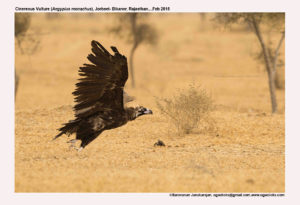Cinerous Vulture

Cinereous Vulture Aegypius monachus
Etymology :
- Aegypius : Greek word aigupios – vulture
- Monachus : Latin word for Monk
Vernacular Names: Hindi: Kala gidh, Lepcha: Gal panom, Guj: Daku, Shahigidh, Mal: Karuth-thakazhukan, Mar: Kale Gidhad
Distribution in India: Resident in North India and Himalayas in India.
Description: Size of 100–120 cm; male weighs 7000–11,500 g, female weighs 7500–12,500 g; wingspan of 250–295 cm. It is one of the world’s heaviest flying birds. The females are slightly larger than males. The cinereous vulture is distinctly dark, with the whole body being brown excepting the pale head in adults, which is covered in fine blackish down. The skin of the head and neck is bluish-gray and a paler whitish color above the eye. The adult has brown eyes, a purplish cere, a blue-gray bill and pale blue-gray legs. The primary quills are often actually black. The massive bill is the largest of any living raptor, a feature enhanced by the relatively small skull of the species. The wings, with serrated leading edges, are held straight or slightly arched in flight and are broad, sometimes referred to as “barn door wings”. Their flight is slow and buoyant, with deep, heavy flaps when necessary. The combination of huge size and dark coloration renders the cinereous vulture relatively distinct, especially against smaller raptors such as eagles or hawks. The immature plumage is sepia-brown above, with a much paler underside than in adults. Immature cinereous vultures have grey down on the head, a pale mauve cere and grey legs. The juvenile has bare pink skin.
Habitat: It is found in forested areas in hills and mountains. It is found from lowlands to 4000m.
Food habits: It feeds on carrion, from medium-sized to large carcasses; only rarely takes live prey likeLizards, snakes and tortoises, and some insects. It is dominant at carcasses; heavy bill capable of tearing through muscles, tendons and skin.
Breeding habits: They breed in Feb–Apr in Spain, Uzbekistan and Mongolia. The nest is an enormous stick nestup in tree and often occupying much of it. They lay a clutch of one egg. The incubation period is 50–62 days. The fledging period is 95–110.